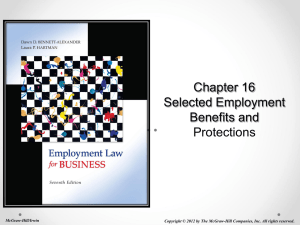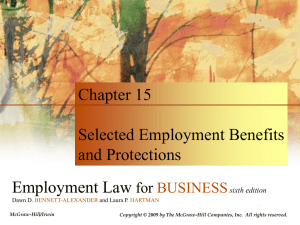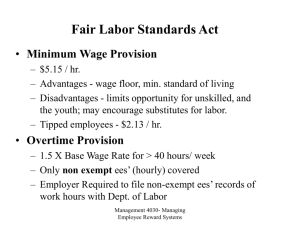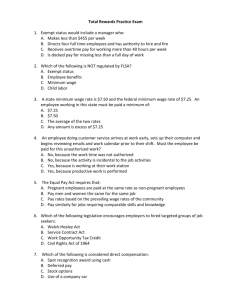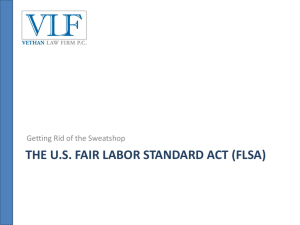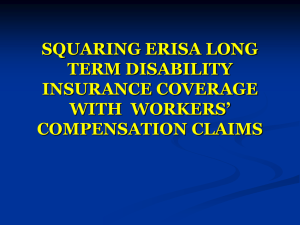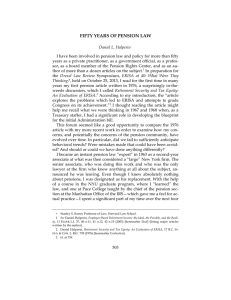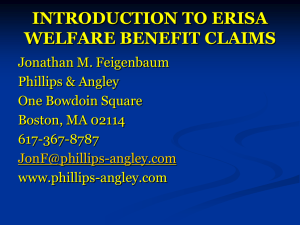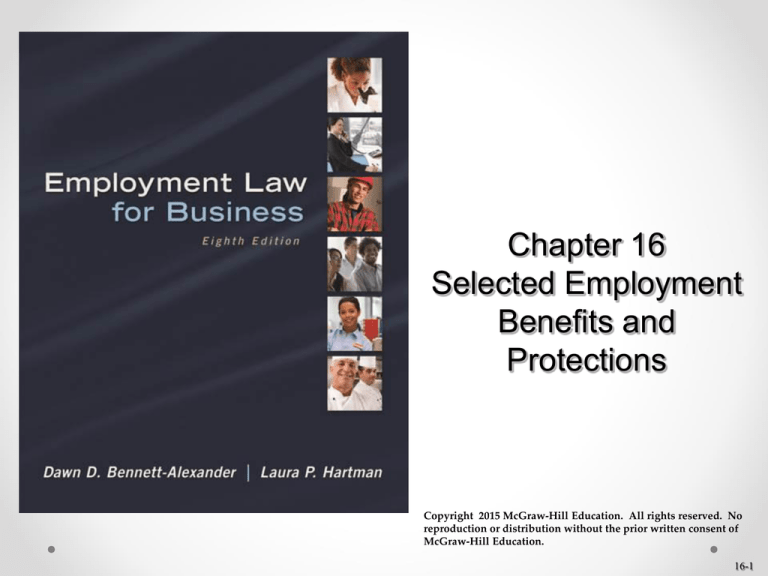
Chapter 16
Selected Employment
Benefits and
Protections
Copyright 2015 McGraw-Hill Education. All rights reserved. No
reproduction or distribution without the prior written consent of
McGraw-Hill Education.
16-1
Learning Objectives (1)
List the matters regulated by the Fair Labor
Standards Act
Understand minimum wage and overtime laws,
their exemptions and the relationship to states
Explain the Family Medical Leave Act, to whom
it applies and under what circumstances
Explain the legal background of workplace
safety, and determine how OSHA has altered
this regulatory environment
16-2
Learning Objectives (2)
Recognize the interplay of the OSHA General
Duty clause, specific standards and defenses.
Describe the reporting responsibilities of
employers under the OSH Act
Explain the purposes of ERISA and identify who
and what type of entities are covered
Describe the minimum ERISA standards for
employee benefit plans
Understand the roles of COBRA and HIPAA
16-3
Show me the Money! (1)
Full circle: worker classification still crucial
Case: Reich v. Circle C Investments, Inc.
Fair Labor Standards Act (FLSA)
Law to regulate pay and hours worked passed in
1938, part of New Deal
Set standards for minimum wage and overtime pay,
regulates child labor, wages and hours
Requires recordkeeping on wages and hours
Violations are big business: small increments x many
hours x many employees in class actions = $$$
16-4
Show me the Money! (2)
FLSA administered by the U.S. Department of
Labor, Wage and Hour Division
Sets floor for min. wage and OT rules – states may
exceed, but not undercut its provisions
Wide variation among states’ coverage
Anti-Retaliation Provision
Case: Mullins v. NYC Police Department
States also have wage and hour provisions
administered by comparable state agencies)
Your state?
16-5
Covered Employees
Two types of coverage in FLSA
Individual coverage
Enterprise coverage
FLSA applies to part-time and full-time employees
Federal, state and local employees are covered
The law also covers domestic service workers
Internships pay issue: 6 criteria
Exemptions, generally
16-6
Minimum Wages
Minimum wage laws established to protect
workers in unbalanced economy (esp. after Wall
Street Crash of 1929)
FLSA – employers must pay employees a
certain minimum hourly wage
$7.25 since 2009, proposal to raise to $9.00
Since 1990: MW up 21%; Cost of Living up 67%
Tipped employees or piece-rate vs. hourly rate
16-7
Minimum Wages and Overtime
Exemptions: general and specific
FLSA overtime regulations (circa 2004)
Businesses required to review their pay levels and
jobs
Employees earning up to $23,660 per year
($455/week) automatically entitled to overtime pay
Employees who earn at least $100,000 per year and
perform some executive, professional, or
administrative job duties are automatically exempt
from overtime provisions
Analysis in-between $23,600 and $100,000
16-8
Overtime Provisions
The FLSA provisions:
Intended in-part to encourage Depression-era hiring
Sets standards for the hours constituting a normal
workweek for wage purposes
Sets wage rates for hours worked over and above the
normal week
Scenario 1
If an employee works over 40 hours, he or she must be
paid time and a half for the time worked in excess of 40
hours
16-9
Child Labor Laws
FLSA sets minimum age standards for allowing
children to work
Most cannot work before age 16
Age 18 the minimum for hazardous jobs
Certain jobs allowed for children 14-16 that do not
interfere with their health, education, or well-being
State child labor laws override federal law
CA: https://www.dir.ca.gov/dlse/ChildLaborLawPamphlet.pdf
Permits, wages, hours, jobs by age, incl. entertainment
industry
16-10
Family and Medical Leave Act
Enacted primarily in response to job retention
after having a child
General provisions
Guarantee job after leave for a birth, an adoption, or care of
sick children, spouses, or parents
Applies to employers with 50 or more employees within a 75mile radius
Employers can require medical confirmation of an illness
Leave is unpaid
May need to be rationalized with similar state law coverage
Scenario 2
16-11
Occupational Safety and Health Act:
Safety at Work
Statistics
4,383 Americans died from workplace injuries in 2012
3 million suffered nonfatal workplace injuries
Workers Comp payments: $1 Billion/Week
According to OSHA:
OSH Act has helped cut workplace fatalities and
injury/illnesses by roughly 2/3 in much larger (but
different) American economy
Note: Multi-employer worksite coverage: Scenario 3
16-12
Defenses to Worker Injury Claims
Former defenses made recovery difficult. Led to
creation of workers comp laws at state level.
Employer’s defense
Explanation
Contributory negligence
Negligence defense based on the injured party’s
failure to exercise reasonable care for her or his
own safety
Assumption of risk
Injured party voluntarily exposed herself or
himself to a known danger created by the other
party’s negligence
Fellow servant rule
Injury occurred on the job and was caused by
the negligence of another employee
16-13
OSH Act General Provisions
Section 5(a)
The employer must comply with all the safety and
health standards dictated by the Department of Labor
The employer must furnish a workplace free of
hazards (General Duty Clause)
OSHA creates specific regulatory standards of
safety for thousands of workplace conditions
General Duty Clause fills-in the gaps between
specific standards
16-14
Enforcement procedures (1)
Responsibility for enforcing the acts rests with
OSHA under the auspices of the Department of
Labor
OSHA conducts routine inspections in certain
high-risk industries, based on reporting stats
Penalties and “abatement orders” are assessed
in connection with an inspection officer’s report
Employers covered by the Act must maintain
records for OSHA compliance
16-15
Enforcement Procedures (2)
Employees must be informed of their OSHA
rights by their employer
Occupational Safety and Health Review
Commission
Willful violation
Increase in fines
Definition of “willful”
16-16
Specific Standards
Physical layout of the worksite
Training
Medical examinations
Setting standards
Voluntary compliance programs
Emergency temporary standards
Continual-training requirement
16-17
General Duty Clause, Defenses
Employer requirement – A place of employment
free from recognized hazards that cause or are
likely to cause death or serious physical harm to
the employee
Instances when employer is not held responsible
Recklessness
Safety requirement is not economically feasible
‘Greater hazard’ defense
16-18
Other Provisions
Intentional Acts
Compensatory and punitive damages
Workplace Violence: “Zero tolerance” policy
Bullying (contrast harassment)
Legal liability and higher worker compensation costs if
left uncontrolled
Retaliation
OSH Act – Prohibits retaliation against whistleblowers
16-19
ERISA: Will It Be There When I Retire?
Many firms offer employees retirement plans,
health care, and other employee benefits
Employee Retirement Income Security Act
(ERISA) 1973
Protects pension benefits of workers
Government entities, churches, non U.S. residents, or
independent contractors not covered
Passed in response to looting of benefits funds
16-20
ERISA
Covers employee benefits (welfare) plans and
retirement or pension plans
Eligibility requirements for employee benefit
plans
Welfare plans (not all benefits covered)
Retirement or pension plans (non-qualified plans)
Establishes requirements for managing and
administering pension and welfare plans
Case: Varity Corp. v. Howe
16-21
ERISA Terminology
Key Terms
Explanation
Employee
benefit plan
Contractual obligation by which an employer or an
employee organization agrees to provide retirement benefits
or welfare benefits to employees and their dependents and
beneficiaries
Retirement or
pension plan
Provides for compensation at retirement or deferral of
income to periods beyond termination of employment
Defined
contribution
Retirement plan where the benefit payable to a participant
are based on the amount of contributions and earnings on
such contributions
Defined
benefit
Retirement plan where the benefit payable to a participant is
defined up front by a formula, the funding of which is
determined actuarially
16-22
Fiduciary Duty of Administrators
Fiduciary: Someone who has discretionary
authority over the investment or management of
plan assets on behalf of others
Fiduciary
requirements
Loyalty
Exclusive purpose
Prudence
Diversification
Compliance with plan documents
16-23
Reporting and Disclosure
Required information
Summary plan description (SPD)
Annual report with the DOL
ERISA was amended by the Pension Protection
Act (PPA) of 2006
Eligibility and Vesting Rules
Benefit plans – 100 percent non-forfeitable after three
years of employment
16-24
Funding Requirements for Defined
Benefit Plans
Minimum standards
Accruals of benefits based on service in each year
Amortization of any prior service or actuarial gains or
losses on investment over a set period of years
Pension Benefit Guarantee Corporation (PBGC)
ERISA litigation
Fiduciary liability
The Worker, Retiree, and Employer Recovery Act
16-25
‘COBRA’ and ‘HIPAA’
Consolidated Omnibus Budget Reconciliation Act
COBRA Applies to group health plan (20≥ employees)
18 mos. coverage post-termination at ‘retail’ rates
Health Insurance Portability and Accountability Act
promote standardization and efficiency in the health
care industry
HIPAA privacy rules
General obligations of covered entities
16-26
Enforcement of ERISA
Employers have the right to reduce or modify
employee benefits
Unless it is prohibited by contractual obligations
Similarly situated participants must be treated alike
ERISA claims – may be asserted under the Age
Discrimination in Employment Act (ADEA)
Case: Central Laborers’ Pension Fund v. Heinz
16-27
Management Tips
Inadequately administered wage-and-hour
systems are costly: ensure proper classification,
hours recording, break times, exemptions
treatment
Be certain to extend FMLA and state leaves to
covered workers
Worker safety: give priority to prevention
Monitor compliance with ERISA regulations,
including COBRA and HIPAA
16-28

